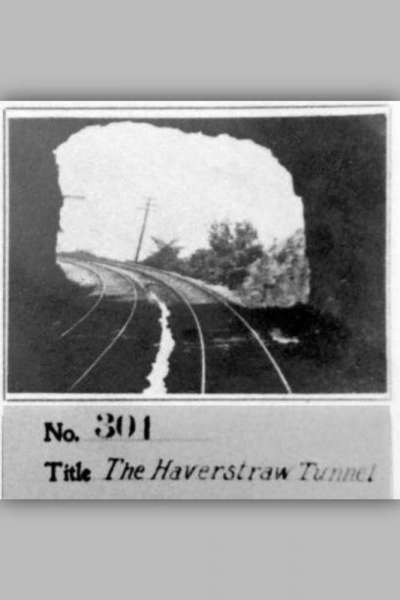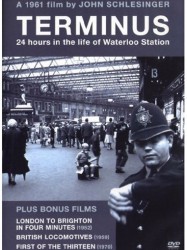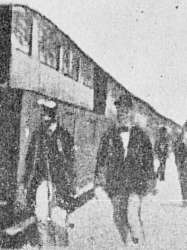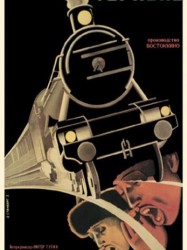The Haverstraw Tunnel est un film américain de genre Documentaire
The Haverstraw Tunnel

Si vous aimez ce film, faites-le savoir !
- Infos
- Casting
- Infos techniques
- Photos
- Vidéos
- Passages TV
- Citations
- Personnages
- Musique
- Récompenses
The Haverstraw Tunnel is an early black and white silent film released in 1897 by the American Mutoscope Company. It is considered to be one of the first examples of a phantom ride (along with Alexandre Promio's Leaving Jerusalem by Railway the same year) and features a train travelling along the West Shore Railroad in Rockland County, New York and then through the eponymous tunnel.
Commentaires
Postez un commentaire :
Suggestions de films similaires à The Haverstraw Tunnel
Il y a 8965 ayant les mêmes genres cinématographiques, 7108 films qui ont les mêmes thèmes (dont 32 films qui ont les mêmes 3 thèmes que The Haverstraw Tunnel), pour avoir au final 70 suggestions de films similaires.Si vous avez aimé The Haverstraw Tunnel, vous aimerez sûrement les films similaires suivants :

Xi wang zhi lü (2002)
, 56minutesRéalisé par Ning Ying (宁瀛)
Genres Documentaire
Thèmes Transport, Le train, Documentaire sur les technologies
Note72%






Terminus (1961)
Réalisé par John Schlesinger
Genres Drame, Science-fiction, Documentaire, Action, Aventure, Horreur
Thèmes Transport, Le train, Documentaire sur les technologies
Acteurs Peggy Ashcroft, Margaret Lacey, John Schlesinger
Note70%






Réalisé par Georges Méliès
Origine France
Genres Documentaire
Thèmes Transport, Le train, Documentaire sur les technologies
Note49%






John Betjeman Goes By Train (1962)
, 10minutesOrigine Royaume-uni
Genres Documentaire
Thèmes Film sur un écrivain, Transport, Le train, Documentaire sur une personnalité, Documentaire sur les technologies
Note72%






Blue Pullman (1960)
Origine Royaume-uni
Genres Documentaire
Thèmes Transport, Le train, Documentaire sur les technologies
Note77%






Turksib (1929)
Réalisé par Victor Tourine
Genres Documentaire
Thèmes Transport, Le train, Documentaire sur les technologies
Note71%





Le film raconte la construction du chemin de fer Turkestan-Sibérie (Türksib) et son rôle dans le développement de la région de Jetyssou. Le réalisateur du film montre l'enthousiasme des constructeurs de la voie et l'étonnement des habitants du désert voyant les voies ferrées posées sur le sable.

Arrival of Tongkin Train (1901)
Origine Etats-Unis
Genres Documentaire
Thèmes Transport, Le train, Documentaire sur les technologies

Snowdrift at Bleath Gill (1955)
, 10minutesOrigine Royaume-uni
Genres Documentaire
Thèmes Transport, Le train, Documentaire sur les technologies
Acteurs Deryck Guyler
Note70%






Taken for a Ride (1996)
, 55minutesOrigine Etats-Unis
Genres Documentaire
Thèmes L'environnement, Transport, Automobile, Le train, Documentaire sur le monde des affaires, Documentaire sur l'environnement, Documentaire sur les technologies, Road movie
Note78%





Taken for a Ride begins with interviews on the inefficiencies and congestion on Los Angeles' highways. Next, the film displays a variety of archival footage on streetcar systems around the United States, demonstrating that streetcars were a widespread and efficient means of transportation. The film continues into a description of the General Motors streetcar conspiracy, starting with a history of National City Lines and Pacific City Lines and General Motors' investment in both companies. The film builds the argument that streetcar systems purchased by these companies were deliberately sabotaged through service reductions and fare increases, then replaced with profitable, less convenient, bus systems. Next, the film makes a connection between this conspiracy and the construction of the Interstate Highway System and the suburbanization of America in the face of the Highway revolts in the 1960s and 1970s. The film ends with footage of the reduction of Philadelphia's trolleybus system at the time of filming.

Journey Into Spring (1958)
, 28minutesOrigine Royaume-uni
Genres Documentaire
Thèmes Transport, Le train, Documentaire sur les technologies
Note71%





 Connexion
Connexion